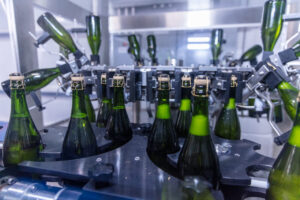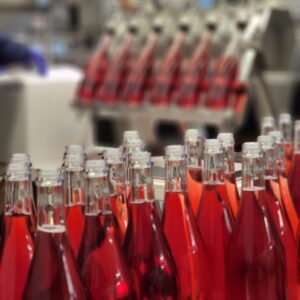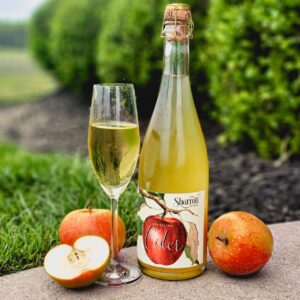U.S. wineries looking to offset negative growth should consider adding sparkling wine
to their portfolios to capture consumers who embrace bubbles.
By Robin Shreeves
Wine consumption has seen two years of negative growth. Along with lagging consumption, most of the major grape varieties — Cabernet Sauvignon, Pinot Noir, Pinot Grigio, Chardonnay and the like — had negative growth rates in 2022.
 Is any wine category growing? Yes. In recent years, sparkling wine has seen robust growth, especially Prosecco and Champagne. According to Shanken News Daily, American bubbles are now catching up. Bottles of U.S.-produced sparkling wine priced $15 and above are on the rise. For example, New Mexico’s Gruet Winery, which specializes in Méthode champenoise sparkling wines, saw a 5% increase in 2022. (Méthode champenoise, also known as the traditional method, is a sparkling wine production method whereby wine undergoes a second fermentation process in the bottle.)
Is any wine category growing? Yes. In recent years, sparkling wine has seen robust growth, especially Prosecco and Champagne. According to Shanken News Daily, American bubbles are now catching up. Bottles of U.S.-produced sparkling wine priced $15 and above are on the rise. For example, New Mexico’s Gruet Winery, which specializes in Méthode champenoise sparkling wines, saw a 5% increase in 2022. (Méthode champenoise, also known as the traditional method, is a sparkling wine production method whereby wine undergoes a second fermentation process in the bottle.)
U.S. wineries looking to offset negative growth should consider adding quality sparkling wine to their portfolios to capture consumers who embrace bubbles.
Making Sparkling Wine In-House
Producing sparkling wine in-house requires additional equipment, space, time and labor. For New Jersey’s Sharrott Winery in the Outer Coastal Plain AVA, a facility expansion allowed them to jump in.
 “We’d been kicking the idea around almost since 2007,” says co-owner Larry Sharrott III. The winery started with pét-nat [aka pétillant naturel, a wine bottled during first fermentation], getting some of the trial and error out of the way before moving on to traditional method.
“We’d been kicking the idea around almost since 2007,” says co-owner Larry Sharrott III. The winery started with pét-nat [aka pétillant naturel, a wine bottled during first fermentation], getting some of the trial and error out of the way before moving on to traditional method.
“We learned a lot making pét-nat,” says Sharrott. “One of the major things was how much CO2 to use.” They also learned their customers were clamoring for sparkling wine.
In 2022, the winery released its first traditional method sparkling wines — a total of 700 cases of Brut and Brut Rosé — both priced at $34.99. The wines have been a success at the winery, and Turning Point Restaurants carries them at five of its N.J. restaurants.
Sharrott offers advice for wineries that want to add sparkling. “Look into what kind of equipment you’re going to need and make sure this is something that you want to get into. Make sure you’re going to make enough wine to cover the cost of the equipment in a reasonable amount of time,” he says.
Also, carefully consider what type of sparkling wine to produce.
 “Are you trying to make a fresh style sparkling such as Prosecco? If you are, Charmat method [which traps bubbles in wine via carbonation in large steel tanks] is honestly cheaper and easier,” Sharrott says. “It doesn’t require all the extra handling during bottling.” But if you want on-the-lees-aged flavors and characteristics, traditional method is the way to go.
“Are you trying to make a fresh style sparkling such as Prosecco? If you are, Charmat method [which traps bubbles in wine via carbonation in large steel tanks] is honestly cheaper and easier,” Sharrott says. “It doesn’t require all the extra handling during bottling.” But if you want on-the-lees-aged flavors and characteristics, traditional method is the way to go.
Finally, he cautions, don’t underestimate the labor involved.
“Unlike still wines, you almost bottle twice. It really is labor-intensive to make traditional method [wine]. If labor is going to be an issue, you’d be better off either not making sparkling wine or using the Charmat method,” he says.
Outsourcing Your Sparkling Wine Production
An option for wineries without the space or labor to produce sparkling wine in-house is using a custom crush facility that will take unfermented juice (or already fermented wine) and do the work of fermenting (if needed), bottling, aging, racking, riddling, disgorging, corking and more.
Rack & Riddle in Healdsburg, Calif., provides custom crush still and sparkling wine services. “It’s very expensive to get into traditional method sparkling wine,” says Mark Garaventa, general manager. “For those doing small volumes, it’s often cost prohibitive.”
 That’s where Rack & Riddle comes in. The company lets wineries outsource much of the work to the facility. “At any given time, we’re working with more than 400 wineries,” says Garaventa. The facility has a team of 130 people, including five winemakers, and produces about 800,000 cases per year in a fully robotic facility. Rack & Riddle can also produce Charmat method, inline carbonation and canning.
That’s where Rack & Riddle comes in. The company lets wineries outsource much of the work to the facility. “At any given time, we’re working with more than 400 wineries,” says Garaventa. The facility has a team of 130 people, including five winemakers, and produces about 800,000 cases per year in a fully robotic facility. Rack & Riddle can also produce Charmat method, inline carbonation and canning.
From a capital expenditure standpoint, Rack & Riddle saves wineries money. “Based on our efficiencies, capabilities and state-of-the-art facilities, we can keep the cost down to our clients,” Garaventa says.
In Afton, Va., Virginia Sparkling Company produces traditional method sparkling wine for about 25 wineries using equipment in-line with Champagne industry standards. Labor is the biggest barrier to entry into sparkling wine production, says Elliott Watkins, director of Virignia Sparkling.
“If you’re producing 100 cases, you can do that relatively inexpensively by hand,” says Watkins. “If you get beyond the 250 to 300 case production level, that’s when you want to introduce some kind of automation.”
 Virginia Sparkling Company offers that automation, and they do it “all from A to Z” as Watkins puts it, including sourcing materials. “I purchase all of the supplies myself,” he says. His fixed fee per case includes glass, caps, corks, cages and labor. Economy of scale drops the price of those items.
Virginia Sparkling Company offers that automation, and they do it “all from A to Z” as Watkins puts it, including sourcing materials. “I purchase all of the supplies myself,” he says. His fixed fee per case includes glass, caps, corks, cages and labor. Economy of scale drops the price of those items.
Each year, Watkins has seen an increase in the number of wineries adding sparkling to their portfolio. And wineries already producing sparkling are increasing production. The trend is clear: whether producing it in-house or outsourcing, now is the time to give customers what they want. Bubbles.
__________________________________________________________________

Robin Shreeves
Robin Shreeves is a drinks journalist and lifestyle features writer. Her wine writing has appeared in dozens of print and online publications including Wine Enthusiast, VinePair, Courier Post, Carpe Travel, Spirited Magazine, Edible Philly, Vintner Project, Edible Jersey, USA Today, and Drink Philly. She holds a Level 3 wine certification and Advanced Wine Speaker certification from the National Wine School.


















